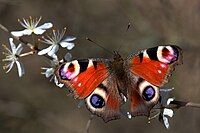
Photo from wikipedia
Nocturnal insects like moths are essential for pollination, providing resilience to the diurnal pollination networks. Moths use both vision and mechanosensation to locate the nectary opening in the flowers with… Click to show full abstract
Nocturnal insects like moths are essential for pollination, providing resilience to the diurnal pollination networks. Moths use both vision and mechanosensation to locate the nectary opening in the flowers with their proboscis. However, increased light levels due to artificial light at night (ALAN) pose a serious threat to nocturnal insects. Here, we examined how light levels influence the efficacy by which the crepuscular hawkmoth Manduca sexta locates the nectary. We used three-dimensional-printed artificial flowers fitted with motion sensors in the nectary and machine vision to track the motion of hovering moths under two light levels: 0.1 lux (moonlight) and 50 lux (dawn/dusk). We found that moths in higher light conditions took significantly longer to find the nectary, even with repeated visits to the same flower. In addition to taking longer, moths in higher light conditions hovered further from the flower during feeding. Increased light levels adversely affect learning and motor control in these animals.
Journal Title: Biology Letters
Year Published: 2021
Link to full text (if available)
Share on Social Media: Sign Up to like & get
recommendations!